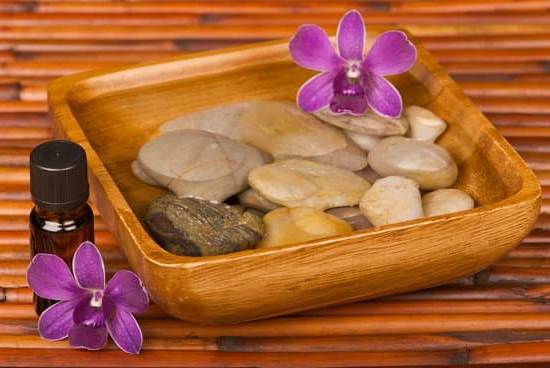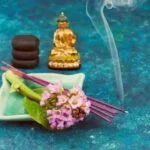then you’re in the right place. In this article, we will explore the basics of aromatherapy and essential oils, helping you understand how to incorporate them into your daily routine for maximum benefit.
Essential oils have been used for centuries for their therapeutic properties. They can be derived from various parts of plants such as leaves, flowers, bark, and roots. Each essential oil possesses its own unique aroma and potential health benefits. From lavender and eucalyptus to peppermint and rosemary, the choices are vast when it comes to selecting essential oils for aromatherapy.
It is important to note that essential oils are highly concentrated and should be used with caution. In this comprehensive guide, we will delve into the proper storage and handling of essential oils to ensure their longevity and maximum benefits. We will also explore different methods of using essential oils for aromatherapy, including inhalation techniques and topical application.
As we embark on this journey of discovering the world of aromatherapy and essential oils, it is vital to prioritize safety guidelines and precautions. By understanding the basics of aromatherapy and familiarizing yourself with different essential oil options, you can harness the power of these natural extracts to enhance your well-being in various settings – whether it’s at home or work.
In the following sections of this article, we will delve deeper into choosing the right essential oils for aromatherapy, proper storage and handling techniques, different methods of using them effectively through inhalation or topical application. Additionally, we’ll explore creating personalized blends that maximize their therapeutic effects and enhancing the atmosphere through diffusing techniques or DIY room sprays. Finally, we’ll give you practical tips on incorporating essential oils into your daily routine while prioritizing safety guidelines and precautions.
Join us as we journey into the world of aromatherapy and learn how to utilize essential oils for maximum well-being.
Choosing the Right Essential Oils for Aromatherapy
When it comes to using essential oils for aromatherapy, selecting the right oils is crucial for achieving the desired therapeutic benefits. With countless options available in the market, it can be overwhelming to choose which ones are best suited for your needs. This comprehensive guide will help you navigate through the wide variety of essential oils and make informed decisions.
One important factor to consider when choosing essential oils is their therapeutic properties. Different oils have different properties that can address specific concerns such as stress relief, relaxation, focus enhancement, or respiratory support. For example, lavender oil is known for its calming and sleep-inducing properties, while peppermint oil is commonly used for treating headaches and improving mental alertness. Researching the specific properties of each oil will help you select the ones that align with your desired outcomes.
Additionally, considering personal preferences and sensitivities is crucial when choosing essential oils. Some individuals may have allergies or sensitivities to certain scents or compounds found in essential oils. If you have any known allergies or sensitivities, it’s important to check the ingredients list before purchasing an oil. Furthermore, some people may prefer floral scents while others prefer citrus or herbal scents. Experimenting with different oils and noting how they make you feel can also help inform your choices.
To assist you in choosing from the vast array of essential oils available, here is a list of popular essential oils and their common uses:
- Lavender: Calming, stress-relief, promoting sleep
- Peppermint: Headache relief, mental alertness
- Eucalyptus: Respiratory support
- Tea tree: Antimicrobial properties
- Lemon: Mood uplifting, promoting concentration
- Orange: Energizing, anxiety relief
Remember that individual experiences with essential oils may vary due to personal physiology and preferences. It is always recommended to start with small amounts and observe any reactions before using them extensively. With this comprehensive guide and your personal preferences in mind, you’ll be able to choose the right essential oils for your aromatherapy needs and enhance your well-being through the power of scent.
Proper Storage and Handling of Essential Oils
Essential oils are highly concentrated plant extracts that can provide numerous benefits when used for aromatherapy. However, in order to ensure maximum benefit and longevity of these oils, proper storage and handling techniques must be followed. By taking the necessary precautions, you can preserve the quality and efficacy of your essential oils.
One important aspect of storing essential oils is to keep them in dark-colored glass bottles. This helps to protect the oils from light exposure, which can degrade their potency over time. Additionally, it is recommended to store the bottles in a cool and dry place, away from direct sunlight or heat sources. This helps to maintain the stability of the oils and prevent oxidation.
Another key consideration is to seal the bottles tightly after each use. Essential oils are volatile substances that can evaporate if not properly sealed. This not only leads to a loss in aroma and therapeutic properties but also decreases the shelf life of the oil.
To further ensure safe storage, it is advisable to label each bottle with the name of the essential oil and its expiration date. Essential oils do have a shelf life, typically ranging from 1-3 years depending on the type of oil. Using expired essential oils can be ineffective or even harmful.
When it comes to handling essential oils, it’s important to use clean utensils such as droppers or pipettes rather than directly pouring from the bottle. This prevents contamination and extends the shelf life of your oil by minimizing exposure to air and bacteria.
By following these proper storage and handling techniques, you can maintain the quality and effectiveness of your essential oils for aromatherapy purposes, ensuring you receive maximum benefits from their use.
Different Methods of Using Essential Oils for Aromatherapy
Inhalation is one of the most common methods of using essential oils for aromatherapy. This method allows the aromatic compounds of the oils to be inhaled directly, providing immediate access to the beneficial properties they offer. There are several techniques for inhalation that can be used to enjoy the therapeutic effects of essential oils.
Direct Inhalation
One simple and effective way to inhale essential oils is through direct inhalation. To do this, you can place a few drops of your chosen oil onto a tissue or cotton ball and hold it close to your nose. Take deep breaths, inhaling the scent deeply into your lungs. Alternatively, you can also put a drop or two of essential oil on your palms, rub them together, cup your hands over your nose and mouth, and inhale deeply.
Steam Inhalation
Another popular inhalation technique is steam inhalation. This method involves adding a few drops of essential oil to hot water and then breathing in the steam. It’s best to use a heat-proof bowl or pot for this method. Boil some water and transfer it into the bowl or pot.
Add 4-6 drops of essential oil to the hot water and stir gently. Place a towel over your head, creating a tent-like structure around the bowl or pot, and lean over it while keeping your face at a comfortable distance. Close your eyes and breathe deeply for about 5-10 minutes.
Aromatherapy Diffusers
Using an aromatherapy diffuser is another effective way to enjoy the benefits of essential oils through inhalation. These devices release the aromatic molecules into the air, allowing you to breathe them in continuously without any effort on your part.
There are different types of diffusers available, including ultrasonic diffusers that use water and nebulizing diffusers that dispense undiluted essential oils. Simply add a few drops of your chosen oil to the diffuser, follow the manufacturer’s instructions, and enjoy the soothing scent that permeates the room.
Inhalation techniques are not only convenient but also provide quick relief from common ailments such as headaches, stress, congestion, and anxiety. It’s important to note that when using essential oils for inhalation, it is necessary to choose high-quality oils from reputable sources to ensure their purity and potency. Additionally, always dilute any essential oil before applying them directly on the skin or using them for steam inhalation to avoid irritation or adverse reactions.
Topical Application of Essential Oils
When it comes to using essential oils for aromatherapy, one popular method is through topical application. This involves directly applying the essential oil onto the skin for absorption. However, it is important to take certain safety precautions to ensure a safe and effective experience.
First and foremost, it is crucial to remember that essential oils are highly concentrated plant extracts. Therefore, they should always be diluted before being applied to the skin. A general rule of thumb is to use a carrier oil, such as coconut oil or jojoba oil, to dilute the essential oil. This not only helps protect the skin from potential irritation but also allows for better absorption of the essential oil.
In addition to dilution, it is recommended to perform a patch test before applying any essential oil topically. This involves applying a small amount of diluted essential oil onto a small area of skin, such as the inner forearm. Wait for at least 24 hours to check for any adverse reactions like redness or itching. If there are no negative reactions, it is generally safe to proceed with topical application.
Once you have taken the necessary safety precautions, you can start exploring different massage techniques using essential oils for aromatherapy. One popular technique is Swedish massage, which involves long strokes and kneading motions to promote relaxation and improve circulation. Another technique is deep tissue massage, which targets specific muscles and helps relieve tension and pain.
Regardless of the massage technique you choose, it is important to remember that everyone’s sensitivity levels may vary. Start with a small amount of diluted essential oil and gradually increase if desired. It is always better to use less than more when first starting out.
By following these safety precautions and effective massage techniques, you can safely enjoy the benefits of aromatherapy through topical application of essential oils. Remember to always consult with a qualified aromatherapist or healthcare professional for personalized guidance and recommended dilution ratios based on your specific needs and health conditions.
Creating Personalized Aromatherapy Blends
One of the most appealing aspects of aromatherapy is the ability to create personalized blends by combining different essential oils. This allows individuals to tailor their aromatherapy experience to their specific needs and preferences, maximizing the therapeutic effects. However, it is important to have a basic understanding of essential oil properties and compatibility in order to create effective blends.
When creating personalized aromatherapy blends, it is crucial to consider the properties of each essential oil being used. Some essential oils have calming and relaxing properties, while others are energizing or uplifting. By understanding these properties, you can choose oils that will complement and enhance one another. Additionally, it is important to consider the potential interactions between different oils and how they will react when blended together.
To create a personalized blend, start by selecting a base note, middle note, and top note essential oil. Base notes are typically heavier oils with longer-lasting scents such as sandalwood or patchouli. Middle notes provide the body of the blend and include oils like lavender or geranium.
Top notes are lighter and more volatile oils that evaporate quickly, such as citrus or mint oils. By combining these different notes in appropriate ratios, you can achieve a balanced and harmonious aroma.
Before applying a new blend directly to your skin or using it in a diffuser, it is recommended to conduct a patch test to ensure that you do not have any allergic reactions or sensitivities. Additionally, keep in mind that some essential oils should be used in smaller quantities due to their potency or potential phototoxicity. Always follow safety guidelines and dilute essential oils properly before applying them topically.
Incorporating personalized aromatherapy blends into your daily routine can greatly enhance well-being and promote relaxation or invigoration depending on your goals. Experiment with different combinations of essential oils until you find the blends that resonate with you. Whether you are looking to relax, boost your mood, or alleviate certain symptoms, personalized aromatherapy blends can be a powerful tool for achieving optimal therapeutic effects.
| Essential Oil Properties | Blending Notes |
|---|---|
| Calming and relaxing | Base note |
| Energizing or uplifting | Top note |
| Provides body of the blend | Middle note |
| Potency or potential phototoxicity | Safety precautions needed during use and dilution required for topical application. |
Enhancing the Atmosphere With Essential Oils
Aromatherapy is not only about using essential oils for personal benefits, but it also provides an opportunity to enhance the atmosphere of a space. Whether you want to create a relaxing ambiance in your home or promote focus and productivity in your workspace, diffusing essential oils and creating your own DIY room sprays can help you achieve the desired effect.
Diffusing Techniques:
One popular method of using essential oils to enhance the atmosphere is through diffusing. A diffuser is a device that disperses essential oil molecules into the air, allowing them to be inhaled and experienced aromatically. There are various types of diffusers available, including ultrasonic diffusers, nebulizing diffusers, heat diffusion, and evaporative diffusion. Each type has its own unique way of distributing essential oil particles into the air.
DIY Room Sprays:
If you prefer a more direct approach to scenting a room, creating your own DIY room sprays can be a fun and effective option. To make a room spray, you will need an empty spray bottle, distilled water or hydrosol as the base, alcohol as a dispersant (optional), and your choice of essential oils. Simply mix the ingredients together in the spray bottle, shake well before each use, and spritz it around the room as needed.
Enhancing the atmosphere with essential oils not only adds fragrance but also provides potential therapeutic benefits depending on the essential oils used. For example, lavender oil can promote relaxation and sleep, while peppermint oil may help improve focus and concentration. It’s important to choose essential oils based on their individual properties to create the desired effect in your space.
| Diffusing Techniques | DIY Room Sprays |
|---|---|
| Ultrasonic diffusers | Empty spray bottle |
| Nebulizing diffusers | Distilled water or hydrosol as base |
| Heat diffusion | Alcohol as a dispersant (optional) |
| Evaporative diffusion | Choice of essential oils |
Incorporating Essential Oils Into Your Daily Routine
Aromatherapy is a versatile practice that can easily be incorporated into your daily routine. Whether you want to relax, focus, or uplift your mood, essential oils can be used in various settings to enhance your well-being. Here are some tips on how to use aromatherapy in different environments.
At Home:
One of the easiest ways to incorporate essential oils into your daily routine is by using them at home. You can start by adding a few drops of your favorite essential oil to a diffuser and let the aroma fill your living space. Lavender, chamomile, and ylang-ylang are great choices for creating a calming atmosphere, perfect for relaxation and unwinding after a long day.
In the Office:
Using essential oils in the office can help improve focus and productivity. Diffusing stimulating scents like peppermint or rosemary can help increase alertness and concentration. Alternatively, you can create a personal inhaler by adding a few drops of your preferred essential oil onto a cotton pad or tissue and sniff it throughout the day when needed. This allows you to enjoy the benefits of aromatherapy discreetly without disturbing others.
During Yoga or Meditation:
Aromatherapy can enhance mindfulness practices such as yoga or meditation. Before starting your practice, apply a diluted blend of grounding oils like cedarwood or sandalwood to your wrists or temples to promote relaxation and centering. You can also spritz an aromatic mist made with floral oils like rose or lavender onto your mat or around the room for an added element of tranquility.
Incorporating essential oils into your daily routine doesn’t have to be complicated. By following these tips, you can enjoy the benefits of aromatherapy no matter where you are – at home, in the office, or during mindfulness practices like yoga or meditation. Remember to always choose high-quality oils, dilute them properly, and familiarize yourself with any safety guidelines or precautions to ensure a safe and enjoyable aromatherapy experience.
Safety Guidelines and Precautions When Using Essential Oils for Aromatherapy
In conclusion, when it comes to using essential oils for aromatherapy, following safety guidelines and taking necessary precautions is of utmost importance. While essential oils can provide numerous benefits for physical and emotional well-being, improper use or mishandling can lead to adverse effects.
To ensure your safety and the effectiveness of aromatherapy, it is essential to properly store and handle essential oils. Keeping them in dark glass bottles away from heat and sunlight helps maintain their potency and extends their shelf life. Additionally, always dilute essential oils before applying them topically to avoid skin irritation or sensitization.
When using inhalation techniques, such as steam inhalation or diffusing, proper ventilation is crucial to prevent excessive exposure. Limiting the duration of inhalation sessions and avoiding direct inhalation from the bottle are also recommended steps to follow.
When it comes to topical application, it is vital to perform a patch test before using a new essential oil on your skin to check for any negative reactions. Furthermore, always remember to dilute essential oils in a carrier oil before applying them directly onto the skin. This not only helps prevent irritation but also aids in proper absorption.
Lastly, if you are pregnant, nursing, or have any underlying medical conditions, it is important to consult with a healthcare professional before using essential oils for aromatherapy. They can provide personalized guidance and ensure that the chosen essential oil is safe for you.
By adhering to these safety guidelines and precautions when using essential oils for aromatherapy, you can enjoy their many benefits while minimizing any potential risks. Always remember that understanding the basics of aromatherapy and choosing the right essential oils are key factors in reaping their maximum therapeutic effects.
Frequently Asked Questions
What Is the Most Effective Way to Use Essential Oils?
The most effective way to use essential oils is through aromatherapy. This method involves inhaling the scent of the oil, which can have various physiological and psychological effects on the body. A few drops of essential oil can be added to a diffuser or a bowl of hot water to release the aroma into the air.
Alternatively, you can put a drop or two of oil onto a tissue or cotton ball and inhale directly from it. Another popular way to enjoy aromatherapy is by adding a few drops of essential oil to a carrier oil and using it for massage. This allows the oils to be absorbed into the skin for additional benefits.
What Are the 3 Ways Essential Oils Can Be Used?
Essential oils can be used in three main ways: topically, aromatically, and internally (although internal use should only be done under proper guidance). Topically, essential oils are often diluted with a carrier oil before being applied to the skin. They can be used in massage oils, lotions, creams, or added to bathwater for relaxation.
Aromatically, oils can be diffused into the air or inhaled directly from an open bottle or tissue. This method stimulates the olfactory system and affects brain activity. Internally, some essential oils can be ingested when deemed safe by experts and used in small amounts as directed.
How Do You Dilute Essential Oils for Aromatherapy?
When diluting essential oils for aromatherapy purposes, it’s important to follow proper guidelines to ensure safety and effectiveness. Generally, you should dilute essential oils with a carrier oil such as sweet almond oil, jojoba oil, or coconut oil. The recommended dilution ratio is typically 2-5% essential oil per volume of carrier oil for adults (e.g., 12-30 drops of essential oil per ounce of carrier oil).
For children and those with sensitive skin, it’s best to use lower dilutions (e.g., 0.5-2%). It’s important not to apply undiluted essential oils directly to the skin as they can be irritating or cause sensitivities. When blending, make sure to mix the oils well before applying them to the skin or using them in aromatherapy preparations.

Are you looking for a natural way to improve your health and wellbeing?
If so, aromatherapy may be the answer for you.





